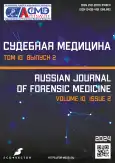Detecting microfragments of glass in scar tissues
- Authors: Tolmachev I.A.1, Antipov V.M.2, Lavrukova O.S.3
-
Affiliations:
- Kirov Military medical academy
- Forensic Medical Expertise Bureau of the Republic of Karelia
- Petrozavodsk State University
- Issue: Vol 10, No 2 (2024)
- Pages: 241-246
- Section: Case reports
- URL: https://bakhtiniada.ru/2411-8729/article/view/262748
- DOI: https://doi.org/10.17816/fm16089
- ID: 262748
Cite item
Abstract
The identification of traumatic causes in the case of damage caused by sharp objects has always been one of the main issues of interest to the investigating authorities. Currently, forensic medicine allows for determining a specific acute traumatic object, including glass fragments. However, in the available literature, no information is available about the possibility of detecting microfragments of glass in the scar. Herein, the case of a man who suffered a chest wound is presented. The patient was brought to the hospital, where the wound was sutured. In the medical records, the wound was described as a stab wound and could have been caused by a knife. The accused categorically denied inflicting a knife wound on this person and argued that the victim was in a state of severe alcoholic intoxication and fell repeatedly, including on a sideboard, glass from which was found during an inspection of the scene. Four months later, the victim died from alcohol poisoning. A forensic medical examination was conducted to confirm the possibility of injury from glass fragments from the sideboard. A scar was identified on the victim’s chest. Microparticles were found in the scar tissue, and their characteristics led to the conclusion that they were microfragments of colorless, transparent glass. Determining the presence of glass microfragments in scar tissue does not require complex technical equipment and are common in wide expert practice; their use has confirmed the possibility of detecting glass microfragments not only in soft tissues along the wound channel but also in scar tissue after wound healing.
Full Text
##article.viewOnOriginalSite##About the authors
Igor A. Tolmachev
Kirov Military medical academy
Email: 5154324@mail.ru
ORCID iD: 0000-0002-5893-520X
SPIN-code: 5794-9030
MD, Dr. Sci (Med.), Professor
Russian Federation, Saint PetersburgVyacheslav M. Antipov
Forensic Medical Expertise Bureau of the Republic of Karelia
Email: sudmedexs7@mail.ru
ORCID iD: 0009-0000-8853-9518
SPIN-code: 8595-7589
Russian Federation, Petrozavodsk
Olga S. Lavrukova
Petrozavodsk State University
Author for correspondence.
Email: olgalavrukova@yandex.ru
ORCID iD: 0000-0003-0620-9406
SPIN-code: 6395-8638
MD, Dr. Sci (Med.), Assistant Professor
Russian Federation, PetrozavodskReferences
- Pinchuk PV, Bozhchenko AP, Nazarova NE. The use of scissors in the commission of crimes against the person (according to the domestic forensic literature). Bulletin Forensic Med. 2022;11(1):40–44. EDN: QNXLJG
- Sarkisyan BA, Karpov DA, Shevchuk DY. Morphological particularity of the damages, caused by splinter glass and sanitary ware. Siberian Med J. 2011;26(1-2):41–45. EDN: NTRIJX
- Gubeeva EG, Spiridonov VA. Forensic examination of damage caused by glass. Meditsinskaya ekspertiza i pravo. 2011;(6):44–46. EDN: OKIFTD
- Rozinov MV. Some methods for identifying damage caused by glass. Forensic Med Expertise. 1966;9(4):23–27. (In Russ).
- Serebrennikov IM. Forensic medical study of skin scars. Moscow: Medgiz; 1962. 127 р.
- Rasnyuk SV, Semov IV, Kislov MA, Miller IV. Morphological features of stab damage generated by the blade of a knife with a broken tip. Russ J Forensic Med. 2018;4(3):32–34. EDN: VTIKYM doi: 10.19048/2411-8729-2018-4-3-32-34
- Leonov SV, Pinchuk PV, Shakiryanova JP, Troyan VN. Possibilities of diagnosing stab-cut wounds in living persons using computed tomography results. Russ J Forensic Med. 2022;8(4):89–96. EDN: EIYOOS doi: 10.17816/fm716
Supplementary files










